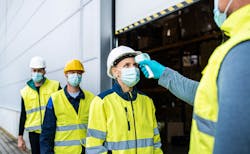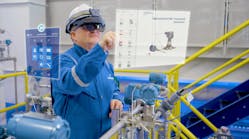Q&A: Optimizing shift handover remotely during continuous plant operations
Remote work has surged during the COVID-19 pandemic. So how do food and beverage processors keep their shift personnel communicating clearly? Plant process management (PPM) helps to coordinate shift-to-shift collaboration – both during the pandemic and beyond. Processing connected with Andreas Eschbach to find out more about PPM and its benefits for processors.
Q: What is PPM and how can food and beverage processors benefit from it?
A: PPM describes digital solutions that help process manufacturing organizations coordinate, monitor and optimize continuous plant operations around work activities and production assets. This helps food and beverage processors quickly adjust to changing supply and demand patterns. It also helps them coordinate work electronically without compromising food safety and regulatory compliance.
PPM has helped process manufacturing teams respond to the challenges of the COVID-19 pandemic by enabling front line managers to shift resources, targets and assignments quickly. They have been able to manage and monitor production in real time at the plant or from the home office. Operators have a digital companion to help them cope with changed processes and tasks, and share job statuses with other shift teams, a critical aspect for 24/7 production.
Q: Collaboration between continuous shifts, such as in food and beverage processing, is important. What are the issues that can occur when the food and beverage processing team is not in sync? How can management communicate to the lowest-level plant worker and vice versa?
A: The key to reliable multi-shift production is how well teams collaborate and communicate to ensure production reliability, quality and performance. Food and beverage processors must deal with challenges in supply and demand as well as workforce constraints, as the pandemic has shown. So now it is more vital than ever that every shift has the tools to work together.
Face-to-face communications are being replaced with digital interactions. Shift handovers, crucial for maintaining smooth production in a 24/7 operation, now need to be handled remotely, with the relief team isolated at the plant from the outgoing shift. Because of changed operations and personnel, more attention must be given on the handover protocol and instructions, which must be carefully supervised by management. The activities of the team, as well as directives of management, must be an open book, accessible to all operators on the team. Increasingly, food and beverage manufacturers rely on digital technology to replace the face-to-face in order to identify and communicate problems and collaborate within the team or other departments to resolve them.
Q: How can food and beverage workers benefit from a single digital document with plant conditions and resolution of past events?
A: With workers more isolated physically, it is particularly important that they now have digital access to data describing the plant conditions — information that previously was communicated verbally or through paper-based communication. This need not be complicated. A single view of the current plant condition or production line status helps immensely. The communications should be visual and in real time — with simple red light/green light indicators to convey completed tasks or workstation status, for example. Giving workers a clear and accurate summary of production with digital tools helps food and beverage workers readily understand current operating conditions, adverse events and how these have been solved previously.
To illustrate, consider fermentation, which is used in a wide variety of food and beverage production and preservation operations. The process involves microorganisms under anerobic conditions, such as yeast or bacteria. The fermentation process can be upset by a variety of factors, such as outside humidity and ambient temperature, which can speed up or slow down the process. Sterilization is also a factor, due to the risk that microbes residing in equipment and storing vessels could cause foodborne illnesses. Keeping the fermentation process running within today’s complex processing equipment can be a constant challenge for operators, who need to take timely action based on many constraints and parameters. Having access to a single digital record and problem resolution database can help operators with less experience react to adverse situations within the time required.
Q: How does shift-to-shift communication help with regulatory issues and hygiene and safety concerns that food and beverage processors need to be cognizant of?
A: Uncompromising hygiene and food safety practices are essential aspects of any food and beverage processing operation. This is not only vital to maintain the trust of federal and state regulators and consumers — it also gives employees confidence and peace of mind. The practice starts with accountability — supported by rigorous inspections and record keeping. Companies need the support of digital technology to support employees as they undertake complex clean- and sterilize-in-place procedures for food processing equipment, storage containers and work areas. Electronic signoffs make employees accountable, and digital audit trails help management ensure compliance while reducing the administrative burden.
Additional safety investments have been made due to the COVID-19 pandemic. One area is contact tracing, where digital platforms are used to keep an electronic record of who was on site at any given shift, which areas they worked in and the identity of any third parties, like external contractors. At Shiftconnector, we have enhanced our offering in this area with a partnership with Cleared4Work to aid in contact tracing. This serves to minimize disruptions to production, loss of employees due to illness and the avoidance of reputational risk.
Q: We know that COVID-19 has impacted food and beverage processors. There is a more urgent need for food processed in a facility and there is more of a concern for cleanliness and social distancing in food and beverage plants. How does a situation where the production line may be changing affect the worker? Where does shift-to-shift communication come in?
A: DSM — the world’s leading supplier of vitamins — was able to keep production humming even as many aspects of daily production changed overnight. The company’s nutritional business unit has been a longtime believer in the Shiftconnector platform, and the solution is deployed at DSM’s major sites worldwide. With Shiftconnector, more DSM production staff could work virtually offsite while still being able to monitor operations and assist staff on site.
Furthermore, DSM believes knowledge sharing is a key differentiator in production, supported with written electronic protocols of production activities and documentation of anomalies. This promotes maximum employee engagement and accountability, which in turn makes sure that no small problems become big enough to hinder production in any way.
Q: How does PPM support emerging technologies and trends in process manufacturing?
A: The Industrial Internet of Things (IIoT) is the most significant macro trend in process manufacturing this century. Accordingly, many food and beverage organizations have made, or are making, major investments in new lines with this advanced technology, focusing on machine control and instrumentation supported by artificial intelligence (AI) with big data. However, the totally automated “lights out” operation is still a long way off; people will continue to be involved in the manufacturing processes for the foreseeable future, albeit with shared responsibility with the automation infrastructure.
The problem is that automation and people each operate within their separate silos. To ensure production reliability and safe operations, the production line of the future will need to leverage automation to provide contextual information to human operators regarding the physical production process at hand. This could be to predict a condition and a possible solution using AI, such as “detected increase in relative humidity, increase drying time of batch, or increase batch temperature.” Conversely, the machines can learn from the documented shift communications, procedures and protocols.
In an industry facing multiple challenges due to demand shifts, supply and COVID-19 protection at the plant, food and beverage processors need to work smarter by leverage new technology for their workforce. PPM, supported by solutions like Shiftconnector, are a great place to start.
Q: How will a typical food and beverage operation benefit from Shiftconnector?
A: For operation teams, Shiftconnector is the single version of the truth regarding production. Shiftconnector allows anyone in operations to create and flag issues, and it supports quicker escalation and problem-resolution processes. Operations teams use Shiftconnector to:
- Document and track any adverse events in production and their resolution.
- Track and measure the effect of equipment downtime as well as performance to plan.
- Manage handovers from shift-to-shift, in person or virtual.
- Ensure protocols for food safety standards are adhered to and audit compliance.
- Provide employees with instant access to standard operating procedures.
- Make production activities and progress transparent to other functions in the company, such as maintenance.
- Help shift teams focus on priority issues and manage escalations.
The system was developed through years of working with leading organizations in the process industries. Shiftconnector seamlessly integrates with automation technologies such as OSIsoft PI as well as maintenance applications and ERP, such as SAP.
Andreas Eschbach is the founder and CEO of the software company eschbach, which helps production teams stay safe and work smarter through better information sharing and collaboration. Holding a degree in computer science, he draws his practical experience from leading a variety of international software consulting, and implementation projects for leading chemical manufacturing companies, focusing on production, continuous improvement, EHS, and maintenance. His company is a provider of manufacturing solutions and headquartered in southern Germany with offices in Boston, Massachusetts.



